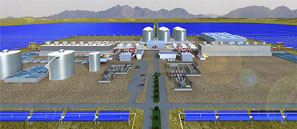Large concentrating solar may not be cost efficient
 Huge concentrating solar power (CSP) projects are attracting a lot of attention and financing because of their potential to reduce the cost of solar power via their levelised cost of energy (LCOE). But a recent study by CSP Today calls that into question, contending that some of the economic efficiencies may not lead to the cost reductions expected.
Huge concentrating solar power (CSP) projects are attracting a lot of attention and financing because of their potential to reduce the cost of solar power via their levelised cost of energy (LCOE). But a recent study by CSP Today calls that into question, contending that some of the economic efficiencies may not lead to the cost reductions expected.
The report “CSP Parabolic Trough Report: Costs and Performance” found that bigger may not always be better in terms of cost reductions for large-scale parabolic trough plants like the 250 megawatt (MW) Abengoa Solar Solano solar project in Arizona. “The reduction in LCOE associated with power block savings is non-linear,” said report author Frédéric Bussières. “As such, going from 50 MW to 100 MW does not double the price, but increases it by 60 percent to 70 percent. This is also true for other equipment, making larger plants more interesting and promising.”
The report found that an optimum size for a CSP trough system is 150 megawatts. “That size is highly site specific and depends highly on the local solar resource, commodity prices, O&M [i.e., operations and maintenance] costs as well as subsidization instruments,” Bussières said. “This conclusion was highly subjective as limited data was available to pose a truly conclusive statement in that regard.”
A number of factors effect the cost of such systems, Bussières said. Chief among them are the parasitic energy costs and the operating and maintenance costs related to scaling up a parabolic trough plant. As such plants get larger, the pumping requirements also grow, requiring more energy, according to Bussières. “Such effects can reduce or even surpass the advantages related to LCOE reductions,” he said.
The study was limited to parabolic trough systems and was further limited by the amount of operational systems and the data they report, according to Bussières. “Due to the limited years of commercial experience of the new era of CSP plants, real data is often limited to developers.…access to up-to-date data from real CSP plants is hard to come by.” he said. “What is clear is that a significant part of these O&M costs are dependent on local expenses such as labour and commodity prices (gas, water and electricity) and therefore lower O&M costs can lead to a higher optimum size.”
Such systems may further reduce LCEO by including thermal storage, though the value of that is still up for debate, according to Bussières. “Some companies are implementing thermal storage while others are not for similar solar resource and site characteristics. There are opposing thoughts within the industry as to what the impact of thermal storage is on LCOE,” he said. “What is clear is that TES has some technical advantages by way of increasing the capacity factor, improving dispatch-ability, extended hours of production and act as a peak shaver on the electrical demand. From an economical point of view, thermal storage appears to reduce LCOE, although at the current prices this reduction is not that big (up to 8 percent in a favorable scenario),” he said.



